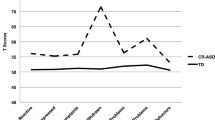Abstract
Two instruments for identifying autism in children and adolescents with intellectual abilities in the normal range were compared. Diagnostic tools consisted of the Autism Behavior Checklist (ABC) and the Autism Diagnostic Interview (ADI). The sample was composed of 18 children who were all diagnosed as having either infantile autism or infantile autism, residual state based on DSM-III criteria by a clinical team using observations, parental interviews, and interactions with the children. Only 4 of the children met diagnostic cutoffs for autism on the current ABC but all met criteria for diagnosis on the ABC using parental recall of the child's behavior at 3–5 years of age. The ADI had somewhat greater specificity in that 3 children did not meet criteria for diagnosis although 2 of these children also received ABC scores based on parental recollection that were in the borderline range.
Similar content being viewed by others
References
American Psychiatric Association. (1980).Diagnostic and statistical manual of mental disorders (3rd ed.). Washington, DC: Author.
American Psychiatric Association. (1987).Diagnostic and statistical manual of mental disorders (3rd ed., rev.). Washington, DC: Author.
DeMyer, M. K. (1979).Parents and children in autism. Washington, DC: V. H. Winston.
Freeman, B. J., & Ritvo, E. R. (1984). The syndrome of autism: Establishing the diagnosis and principles of management.Pediatric Annals, 13, 284–296.
Freeman, B. J., Ritvo, E. R., Guthrie, D., Schroth, P., & Ball, J. (1978). The behavioral observation scale for autism: Initial methodology, data analysis, and preliminary findings on 89 children.Journal of the American Academy of Child Psychiatry, 17, 576–588.
Freeman, B. J., Ritvo E. R., & Schroth, P. (1984). Behavior assessment of the syndrome of autism: Behavior observation system.Journal of the American Academy of Child Psychiatry, 23, 588–594.
Krug, D. A., Arick, J. R., & Almond, P. J. (1980).Autism screening instrument for educational planning. Portland, OR.: ASIEP Education.
Le Couteur, A., Rutter, M., Lord, C., Rios, P., Robertson, S., Holdgrafer, M., & McLennan, J. D. (1989). Autism Diagnostic Interview.Journal of Autism and Developmental Disorders, 19, 363–389.
Lord, C., Rutter, M., Goode, S., Heemsbergen, J., Jordan, H., Mawood, L., & Schopler, E. (1989). Autism diagnostic observation schedule. A standardized observation of communicative and social behavior.Journal of Autism and Developmental Disorders, 19, 185–212.
Mesibov, G. B., Schopler, E., Schaffer, B., & Michal, N. (1989). Use of the Childhood Autism Rating Scale with autistic adolescents and adults.Journal of the American Academy of Child and Adolescent Psychiatry, 28, 538–541.
Rutter, M. (1978). Diagnosis and definition of childhood autism.Journal of Autism and Developmental Disorders, 8, 139–161.
Rutter, M., & Schopler, E. (1987). Autism and pervasive developmental disorders: Concepts and diagnostic issues.Journal of Autism and Developmental Disorders, 17, 159–186.
Schopler, E., Reichler, R. J., DeVellis, R. F., & Daly, K. (1980). Toward objective classification of childhood autism: Childhood autism rating scale (CARS).Journal of Autism and Developmental Disorders, 10, 91–103.
Sevin, J. A., Matson, J. L., Coe, D. A., Fee, V. E., & Sevin, B. M. (1991). A comparison and evaluation of three commonly used autism scales.Journal of Autism and Developmental Disorders, 21, 417–432.
Siegel, B., Anders, T. F., Ciaranello, R. D., Bienenstock, B., & Kraemer, H. C. (1986). Empirically derived subclassification of the autistic syndrome.Journal of Autism and Developmental Disorders, 16, 275–292.
Teal, M. B., & Wiebe, M. J. (1986). A validity analysis of selected instruments used to assess autism.Journal of Autism and Developmental Disorders, 16, 485–494.
Volkmar, F. A., Cicchetti, D. V., Dykens, E., Sparrow, S. S., Leckam, J. F., & Cohen, D. J. (1988). An evaluation of the autism behavior checklist.Journal of Autism and Developmental Disorders, 18, 81–97.
Wadden, N. P. K., Bryson, S. E., & Rodger, R. S. (1991). A closer look at the Autism behavior checklist: Discriminant validity and factor structures.Journal of Autism and Developmental Disorders, 21, 529–541.
Wing, L., & Gould, J. (1978). Systematic recording of behaviors and skills of retarded and psychotic children.Journal of Autism and Childhood Schizophrenia, 8, 79–98.
Yirmiya, N. & Sigman, M. (1991). High-functioning individuals with autism: Diagnosis, empirical findings and theoretical issues.Clinical Psychology Review, 11, 669–684.
Yirmiya, N., Sigman, M., Kasari, C., & Mundy, P. (1992). Empathy and cognition in high-functioning children with autism.Child Development, 63, 150–160.
Author information
Authors and Affiliations
Additional information
Preparation of this paper was supported by NINCDS grant NS 25243 and NICHD grant HD 176620 to the second author. Special thanks are extended to Robin L. Gilmore, Mike Espinosa, Margie Greenwald, Larry Epstein, Mary Louise Bland, and Alma Lopez for assistance in various stages of the project; to Robert Asarnow and Linda Bott for diagnosing the children using DSM-III criteria; and to Lindi Martinez and Cory Shulman for their help with the ADI. We appreciate the cooperation of the families who participated in the study.
Rights and permissions
About this article
Cite this article
Yirmiya, N., Sigman, M. & Freeman, B.J. Comparison between diagnostic instruments for identifying high-functioning children with autism. J Autism Dev Disord 24, 281–291 (1994). https://doi.org/10.1007/BF02172227
Issue Date:
DOI: https://doi.org/10.1007/BF02172227




